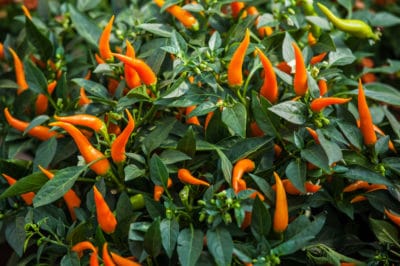Type of Pepper
Peppers with smaller fruits tend to produce more fruits. While a healthy bell pepper plants may produce 4-6 large sweet bell peppers, a chili plant might give 30-60 small spicy fruits. Once fruiting, peppers will continuously fruit until the temperature doesn’t allow it anymore. Length of growing season will affect yields, and picking peppers regularly will encourage more production.
Here are some popular peppers and their average yields:
- Banana Pepper: Sweet 4-6 inch fruit, 20-30 per plant
- Jalapeno Pepper: Hot 3 inch fruits, 25-35 per plant
- Habanero Pepper: Hot small 1-2 inch fruits, 50-60 per plant
- Carmen Sweet Italian Pepper: Sweet 4 inch fruits, 25 per plant
- Big Bertha Bell: Hybrid sweet bell 7-8 inch fruits, 4-7 per plant
Increasing Yields
Get pepper started early so that when the warm weather hits they are ready to produce. This may mean starting them indoors and transplanting outside later. Regulate watering to a strict schedule. Don’t let the soil go through wet and dry extremes, water 2 inches per week and adjust for precipitation.
Mulching the bases of pepper plants will keep them protected, moist, and improve the overall health of plants. When the pepper plants begin to move from flowering into fruiting, fertilize them with some compost as a topdressing or compost tea.
Keep pepper plants in their ideal temperature range of between 70-80°F (21-26°C). If plants get too cold or too hot, pepper production may slow because of stress. Support your plants with a wire cage or trellis so they can climb and shade them from the sweltering sun.
There are some pruning techniques in the gardening world for increasing pepper yields, though not all gardeners agree that they work. As the plant grows, cut some branches at node sites to encourage the plant to bush out. Prune routinely paying attention to the shape of the plant as it grows to encourage even growth in all directions.
Pinching off early blooms can encourage larger fruits later in the season. Gardeners in warm climates with long seasons will benefit more from this practice.
Combating Low Yields
There are several reasons that a pepper plant may not produce. Watering, temperature, and over fertilization are top concerns. Another common issue is pollination. Pepper flowers should pollinate themselves but often need a bit of help from insects and wind, hand-pollinate your peppers to ensure maximum yields.
